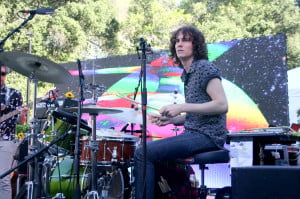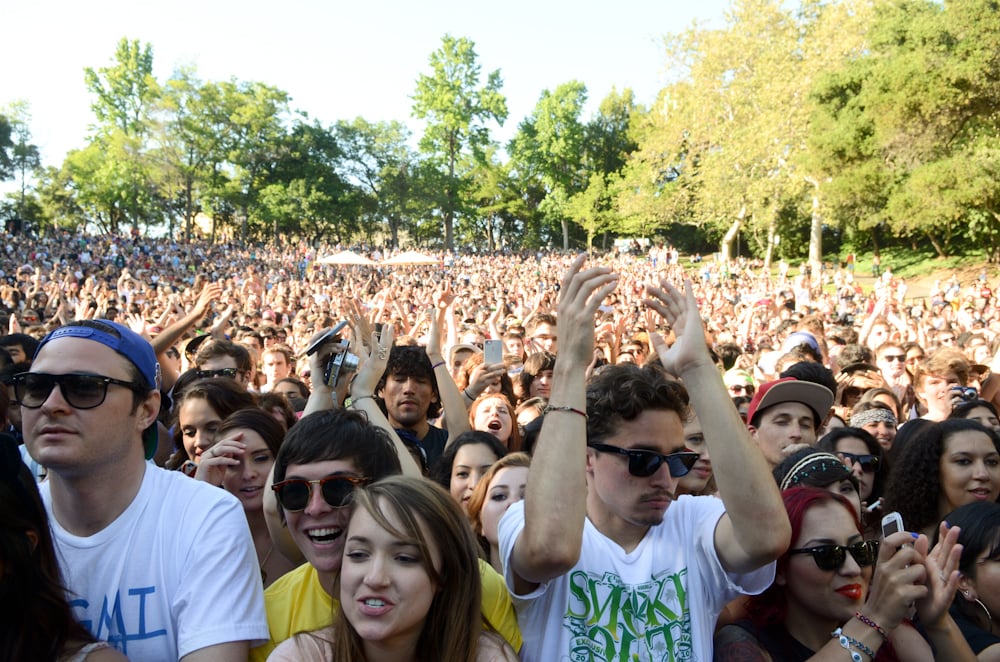
Headliners MGMT filled Laurence Frost Amphitheatre on Saturday afternoon with more than 5,000 students and guests, but never performed high school hit “Kids,” their most famous song.
“It was such a good crowd, and the arts [exhibits] were super cool,” said concertgoer Uché Uba ’15. “The actual performance was a bit of a letdown. It wasn’t like the MGMT songs that we listen to and enjoy. It was slightly annoying that we paid $19 to not have ‘Kids’ performed.”
Stanford Concert Network (SCN) revived the Frost Music and Arts Festival last year after a hiatus lasting almost three decades. The venue had previously hosted artists like Grateful Dead, Jefferson Airplane, Santana and the San Francisco Symphony throughout the ’70s and ’80s, a legacy that served to inspire the amphitheatre’s return.
“We were trying to revive it to its glory days, when Stanford encouraged a lot more freedom of expression and music on campus,” said Alberto Aroeste ’13, SCN’s creative director. “It took selling out the capacity of Frost—around 5,000 [people]—to get the event to happen”
The festival returned around $90,000 in profit this year, which was driven by revenues from 5,000 advance ticket sales and another 100 sold on the day of the show. General admission tickets sold for $40 and student tickets were subsidized to $20.
“We didn’t sell out last year [for Modest Mouse,] but we sold out about a week early this year,” Aroeste said. “That really shows that there’s a growing demand for stuff like this at Stanford.”
According to Haley Sayres ’14, co-director of Frost Revival, the vast majority of costs came from putting on an event of that scale.
“Booking MGMT was about $100,000,” she said. “Security, production and the cost of the infrastructure for Frost Amphitheatre cost us maybe another $100,000.”
Food trucks and merchandise were available outside the venue, but an organizational hitch stopped the sale of Frost-specific merchandise.
“The food trucks come in for free and keep the money they make,” Sayres said. “MGMT had their own merchandise that they were selling, but we were unable to sell Frost shirts with our design this year because we didn’t get it approved in time.”
Sayres said that she hopes to use the profit from this year’s event towards putting on a future event that mimics the atmosphere of music festivals.
“We’ll have more money for next year, so we’re hoping to book a more popular band for the opening band to make the line-up more even so it’s more of a festival feel,” she said. “We’re also going to expand the art, and hopefully have more pieces.”
Event security was fairly tight, with Stanford University Department of Public Safety officers checking bags and refusing to admit any opened drinks. Security refused to return bottles and canteens to guests after the event.
“I thought it was a bit ridiculous that you couldn’t bring any drinks in at all,” said Ross Thorburn ’15. “I had just bought mine at the vendors—they could have smell tested it or something instead of flat out refusing to let it in.”
Art was a major feature of this year’s efforts to increase the event’s festival atmosphere. There were 17 installations in total, including two by professional artist Michael Christian, whose work has been featured at acclaimed festivals like the Coachella Valley Music and Arts festival.
“Christian does Burning Man, Coachella [and] he’s working on a project for [electronic music festival] EDC right now,” Aroeste said. “It’s taken us all quarter to build [the art for Frost.]”
Aroeste emphasized the commitment to integrating the art into the Frost experience.
“Last year we kind of kickstarted the art movement—we had very little money and only five projects,” he explained. “This year, we wanted to create a movement where we were highlighting art on campus—student art—so doing that at Frost became a priority for every group we talked to.”
The added emphasis on arts was well received.
“A lot of people did seem to really enjoy it,” Thorburn said, describing the art exhibitions as well integrated and popular. “The face painting and sculptures were a very good addition.”
Aroeste expressed optimism about Frost’s ability to enjoy continued growth in the future.
“Now that I’m a senior, I’m thinking ahead,” he said. “When we’re all alumni, I definitely want to have events to come back to that will get everyone back together.”
